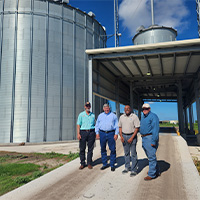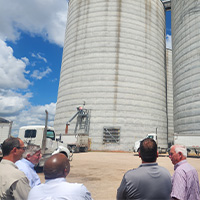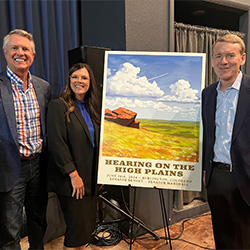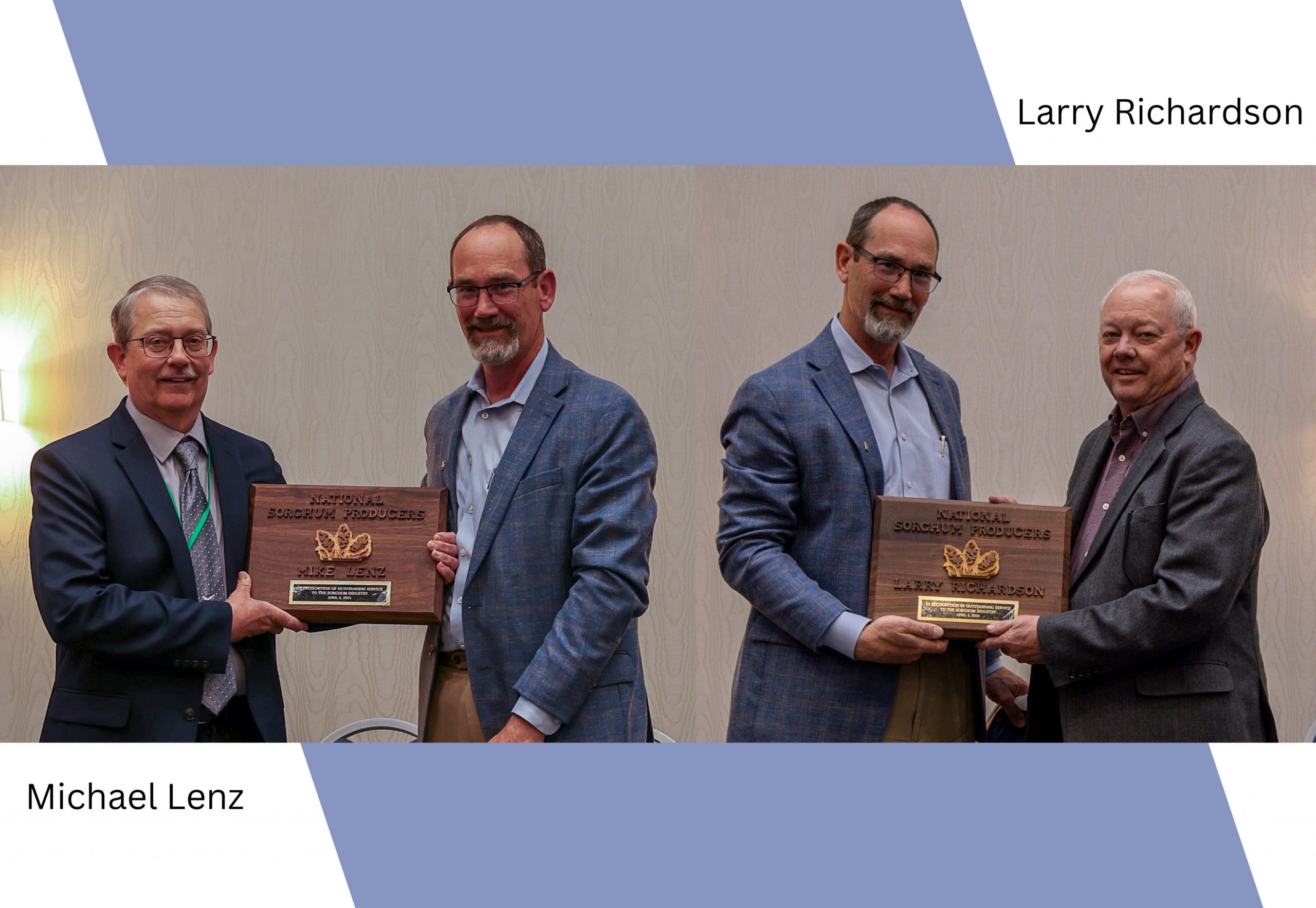
Swipe For More >
Summer 2024 NSP Update
Counting Crops and Counting on Data: Why NASS Surveys Matter
Article by Sydney Lundberg
National Sorghum Producers hosted the USDA National Statistics Agriculture Service (NASS) staff this summer in the Texas Coastal Bend for an in-depth look at sorghum harvest and continue conversations regarding NASS data.
NSP initially engaged with NASS in the early fall of 2023 after discovering significant discrepancies in the reported price of sorghum. Over the past year, NSP has worked in coordination with NASS to not only resolve the immediate issue, but, more importantly, to unearth the root cause and ensure accurate price reporting moving forward.
Why NASS Data Is Important
The reports produced by NASS influence the values used in publications by other government agencies, both within and outside of USDA. As increased cost of production and the farm safety net have been at the forefront of farm bill discussions this year, NASS price data has had significant policy implications.
It is used in production cost estimates developed by the Economic Research Service (ERS), calculating the cost of policy changes by the Congressional Budget Office (CBO), and, specifically for sorghum, NASS price data is used in the price election methodology, which is in turn used to set reference prices for the Agriculture Risk Coverage (ARC) and Price Loss Coverage (PLC) commodity programs.
Each of these play a significant role in determining the changes that will or will not be made to Title I in the coming farm bill; therefore, accurate data is vital to effectively demonstrate the urgent need for an increased safety net for farmers.
NASS Visits Texas Coastal Bend
In June, Wil Hundle, NASS Regional Director, and Troy Joshua, NASS Statistics Division Director, joined NSP staff in the Corpus Christi area for a two-day harvest tour. Over the course of the visit, the group was joined by NSP board directors Scott Frazier and Danny Beyer to tour grain elevators, on-farm storage facilities and the Port of Corpus Christi.
This combination of sites provided an invaluable first-hand opportunity for NASS staff to see and experience the impressive hustle of South Texas sorghum harvest and interact with growers, elevator managers, grain merchandisers and port superintendents.
Each individual the group met with briefed NASS staff on the volume and rapidly shortening timeline of harvest throughout the region. As the visit progressed, it became increasingly apparent that consolidation of the agricultural industry coupled with technological advancements is resulting in more and more sorghum being transported directly from the field to the port, foregoing elevators and impacting NASS price data collection. Driving past a mile and a half long line of trucks waiting to offload sorghum at the Port of Corpus was an impactful experience for the group, learning the grain would be loaded directly onto the second of seven ships this season destined for export to China.



Producer Attitude Toward NASS Surveys
Overwhelmingly, the individual producers who spoke with NASS expressed reluctance to share their personal data. Discussions centered on hesitation to share data other USDA agencies already had, the inconvenience of surveys, inaccuracies in reported data and, most commonly
occurring, the lack of value sensed by growers in completing them.
The first core value of NASS is trust. The agency holds firm to this pillar and protects the data it has been entrusted with as well as the privacy of the individual or business which reports the data. This is not only important to NASS staff, but further it is enforced by law. NASS is subject to the Confidential Information Protection and Statistical Efficiency Act, which ensures that data collected for statistical purposes may not be used to identify individuals or businesses.
Although this summer’s in-person experience with NASS will lead to improved data collection and reporting for sorghum, the data the agency is able to provide is only as accurate as the data it receives. While they can be cumbersome, the surveys sent out by NASS can be a valuable tool. The information is used to produce various reports, which ultimately impact the outcome of policy. Additionally, NASS reports are available to the public and may be used as a tool by growers to influence grain marketing, planting decisions, cost of production estimates and future financial investment decisions.
When accurate data is provided, value-added impacts to the industry and your operation can result. Look for a second installment of analysis into NASS, data collection and data use in the next issue of Sorghum Grower this fall.
###
Understanding the Corporate Transparency Act: What Farms and Agribusiness Need to Know
By Greg Ruehle
The Corporate Transparency Act (CTA) was enacted into law in 2021 with reporting set to begin this year. The CTA requires businesses registered in the United States to report information on those individuals who benefit from the business as owners and investors. For farmers and agribusinesses, this means increased transparency in ownership and control, impacting the way you manage and report your business operations, or you could face a fine.
In order to achieve the objectives of the CTA, the Department of Treasury, which provides oversight through the Financial Crimes Enforcement Network (FinCEN), will provide financial institutions, law enforcement agencies and other authorized users conditional access to a directory of data containing information on who either owns a business or holds an equity interest.
More Main Street than Wall Street
The CTA focuses on businesses with fewer than 20 full-time employees, $5 million or less in gross receipts or sales and an operating presence in the United States. Corporations, partnerships and other business entities, estimated to total at least 32 million, that are not considered exempt, must seek an exception or file a beneficial ownership interest (BOI) form by Jan. 1, 2025, or face civil penalties (up to $500/day) and criminal penalties (up to two years imprisonment).
Under the CTA, a beneficial owner is defined as an individual who either holds significant control over a company or possesses 25% or more of the company’s ownership interests. There are 23 types of entities exempt from the BIO reporting requirements. These entities include publicly traded companies meeting specified requirements, many nonprofits and certain large operating companies. For a full list of exempt entities, visit www.fincen.gov/boi-faqs.
Why This Matters for Farmers and Agribusinesses
Farmers and agribusinesses need to be aware of the CTA, especially those structured as LLCs, corporations or limited partnerships, as they may fall under the CTA’s reporting requirements. Understanding and complying with these regulations is crucial to avoid significant penalties.
Farm operations often involve complex ownership structures with multiple family members holding various stakes in the business. The CTA’s requirements mean that every individual who benefits from the farm must be reported, ensuring transparency in ownership and control.
Deadlines and Penalties
Unless you have filed for an exemption, the initial report is due Jan. 1, 2025. New entities formed during 2024 must report within 90 days of being organized. New entities starting in 2025 and forward must report within 30 calendar days of their formation. Any updates to the
BOI report must be made within 30 calendar days of the change in information submitted.
Understanding the CTA and its implications is essential. Staying informed and compliant will help ensure your business operates smoothly within the law. For specific questions related to the CTA, it is recommended to contact your Secretary of State office.
###
Combating Drought with Innovation: NSP Vice Chair Amy France Testifies
By Jennifer Warren
 Amy France, Vice Chair of the National Sorghum Producers, testified in June at the U.S. Senate Committee on Agriculture, Nutrition, and Forestry’s Republican Subcommittee on Conservation, Climate, Forestry, and Natural Resources. The hearing, “Hearing on the High Plains: Combatting Drought with Innovation,” addressed innovative solutions to drought challenges.
Amy France, Vice Chair of the National Sorghum Producers, testified in June at the U.S. Senate Committee on Agriculture, Nutrition, and Forestry’s Republican Subcommittee on Conservation, Climate, Forestry, and Natural Resources. The hearing, “Hearing on the High Plains: Combatting Drought with Innovation,” addressed innovative solutions to drought challenges.
France stressed the critical need for a stable water supply, highlighting the importance of adapting new technologies, improving practices and policies, and utilizing drought-resistant crops like sorghum. She said, “The agriculture sector has put great time and effort into keeping pace with technological advances and other conservation efforts in response to both market and environmental demands. As a farmer on the High Plains, my vision is to make agriculture more sustainable so that future generations can have the same opportunities we have today.” Read or watch her full testimony at agriculture.senate.gov/hearings.
###
National Sorghum Producers Honors Michael Lenz And Larry Richardson With Outstanding Achievement In Sorghum Improvement Awards
By Jennifer Warren
National Sorghum Producers presented Michael Lenz and Larry Richardson with awards for Outstanding Achievement in Sorghum Improvement at the Sorghum Improvement Conference of North America in April. These awards, presented at the biennial gathering of the U.S. sorghum research community, acknowledge and honor their exemplary service and achievements in the sorghum industry.
Lenz’s career began following his graduation from Iowa State University in 1980, leading him to significant roles at several prominent companies in the sorghum industry. His innovative breeding strategies have significantly shaped the sorghum landscape, addressing critical issues such as greenbug biotypes and ergot. His work has led to the release of over 50 commercial hybrids under 25 unique sorghum brands, making a substantial impact on the U.S. sorghum industry.
“Not only can we contribute the release of many new commercial hybrids to Mike Lenz and his work with sorghum,” NSP CEO Tim Lust said, “but he also led the development of molecular markers for downy mildew resistance and eliminating tall off-types in sorghum fields, which have set new standards for crop uniformity and disease resistance.”
The second award recipient, Larry Richardson, has dedicated his career to advancing the sorghum seed industry through his leadership at Richardson Seeds. Since his start in 1981, Richardson has steered the company to become a frontrunner in producing food-grade and ultra-short grain sorghum varieties. Richardson Seed was also one of the first companies to commercialize and promote BMR sorghum for silage as well as the grazing and hay markets.
“Richardson’s commitment extends beyond his company and work with the seed industry,” Lust said. “He has been a fervent leader through many organizations, including the NSP board of directors, and his integrity and proactive leadership continue to influence industry standards and practices, earning him widespread respect and admiration across the sorghum industry.”

The award for Outstanding Achievement in Sorghum Improvement was first presented in 1961. Recipients include, among others, the forefathers of the modern hybrid sorghum industry. As of today, more than 60 individuals have received this award. Visit SorghumGrowers.com/recognition to view past award recipients.
###
These stories originally appeared in the Summer 2024 Issue of Sorghum Grower magazine.


